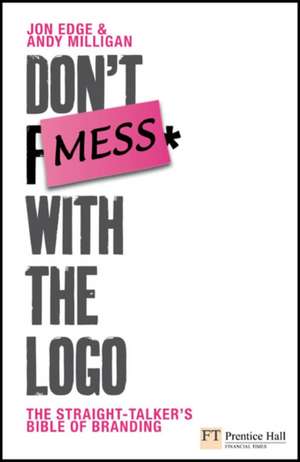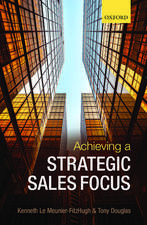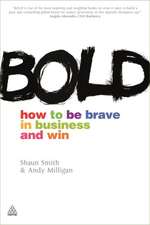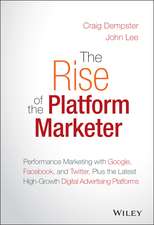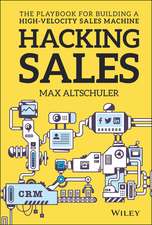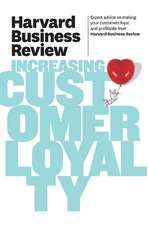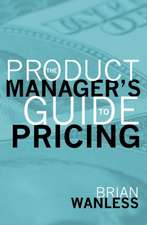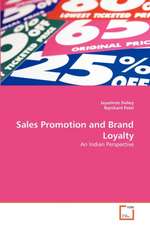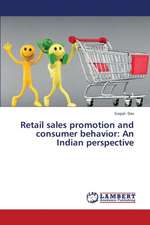Don't Mess with the Logo: Financial Times Series
Autor Andy Milligan, Jon Edgeen Limba Engleză Paperback – 30 iul 2009
This is a different kind of business book. You will find no jargon or dense, theory-laden text.
Building a brand with impact is one of the most important tasks that any business faces. Few people understand how to actually go about creating an effective brand. This book is a no holds barred guide to what brand building is, what it isn't and exactly what you have to do to build your brand.
Be inspired by real-life stories from the people who did and didn't mess with their logo and succeeded or failed as a result. Read the stories from big-name brands like Orange, M&S, Red Bull, Apple, Innocent, PwC and FCUK.
There are numerous brand books but they either fall into the dull, worthy and theoretical which nobody reads or they tell case studies of famous brands which are soon out of date and which do not easily translate into practical advice. This book is unashamedly the antidote to that. It will tell you all you need to know about branding and entertain you at the same time.
Din seria Financial Times Series
- 23%
 Preț: 637.64 lei
Preț: 637.64 lei -
 Preț: 167.04 lei
Preț: 167.04 lei -
 Preț: 132.53 lei
Preț: 132.53 lei -
 Preț: 250.28 lei
Preț: 250.28 lei -
 Preț: 315.59 lei
Preț: 315.59 lei -
 Preț: 133.18 lei
Preț: 133.18 lei -
 Preț: 268.38 lei
Preț: 268.38 lei -
 Preț: 109.53 lei
Preț: 109.53 lei -
 Preț: 230.69 lei
Preț: 230.69 lei -
 Preț: 109.63 lei
Preț: 109.63 lei -
 Preț: 266.11 lei
Preț: 266.11 lei -
 Preț: 173.61 lei
Preț: 173.61 lei -
 Preț: 224.30 lei
Preț: 224.30 lei -
 Preț: 312.89 lei
Preț: 312.89 lei -
 Preț: 117.60 lei
Preț: 117.60 lei -
 Preț: 132.88 lei
Preț: 132.88 lei -
 Preț: 232.07 lei
Preț: 232.07 lei -
 Preț: 175.13 lei
Preț: 175.13 lei -
 Preț: 249.54 lei
Preț: 249.54 lei -
 Preț: 124.71 lei
Preț: 124.71 lei -
 Preț: 195.46 lei
Preț: 195.46 lei -
 Preț: 110.12 lei
Preț: 110.12 lei -
 Preț: 241.24 lei
Preț: 241.24 lei -
 Preț: 170.39 lei
Preț: 170.39 lei - 19%
 Preț: 466.80 lei
Preț: 466.80 lei -
 Preț: 117.34 lei
Preț: 117.34 lei -
 Preț: 118.56 lei
Preț: 118.56 lei -
 Preț: 139.86 lei
Preț: 139.86 lei -
 Preț: 251.10 lei
Preț: 251.10 lei -
 Preț: 209.55 lei
Preț: 209.55 lei -
 Preț: 94.22 lei
Preț: 94.22 lei -
 Preț: 132.99 lei
Preț: 132.99 lei -
 Preț: 111.74 lei
Preț: 111.74 lei -
 Preț: 124.92 lei
Preț: 124.92 lei -
 Preț: 175.75 lei
Preț: 175.75 lei -
 Preț: 231.50 lei
Preț: 231.50 lei -
 Preț: 216.04 lei
Preț: 216.04 lei -
 Preț: 186.51 lei
Preț: 186.51 lei -
 Preț: 133.26 lei
Preț: 133.26 lei -
 Preț: 172.35 lei
Preț: 172.35 lei -
 Preț: 192.77 lei
Preț: 192.77 lei -
 Preț: 263.76 lei
Preț: 263.76 lei -
 Preț: 133.04 lei
Preț: 133.04 lei -
 Preț: 208.22 lei
Preț: 208.22 lei -
 Preț: 232.96 lei
Preț: 232.96 lei -
 Preț: 230.78 lei
Preț: 230.78 lei -
 Preț: 146.70 lei
Preț: 146.70 lei -
 Preț: 250.69 lei
Preț: 250.69 lei -
 Preț: 164.54 lei
Preț: 164.54 lei
Preț: 132.97 lei
Nou
Puncte Express: 199
Preț estimativ în valută:
25.44€ • 26.64$ • 21.05£
25.44€ • 26.64$ • 21.05£
Carte disponibilă
Livrare economică 15-29 martie
Livrare express 01-07 martie pentru 25.86 lei
Preluare comenzi: 021 569.72.76
Specificații
ISBN-13: 9780273714200
ISBN-10: 0273714201
Pagini: 240
Ilustrații: Illustrations
Dimensiuni: 140 x 214 x 18 mm
Greutate: 0.39 kg
Ediția:1
Editura: Pearson Education
Seria Financial Times Series
Locul publicării:Harlow, United Kingdom
ISBN-10: 0273714201
Pagini: 240
Ilustrații: Illustrations
Dimensiuni: 140 x 214 x 18 mm
Greutate: 0.39 kg
Ediția:1
Editura: Pearson Education
Seria Financial Times Series
Locul publicării:Harlow, United Kingdom
Descriere
"Jon and Andy lay out a road-map for great brand management, packed with
the essentials of brand theory and practical tips to make it happen. It does
for brand management what the Haynes workshop manuals do for cars."
Peter Gowers, Chief Executive, InterContinental Hotels Group, Asia-Pacific
"Brands are about difference and personality. This book really is different. It makes you think and makes you smile!"
Peter Fisk, The Genius Works
"Branding isn't rocket science but it sometimes pretends to be. Here's abook without such pretensions, a book to make you smile, learning while you smile."
John Simmons, Director, The Writer
"an enjoyable read full of practical tips. There is far too much jargon in business generally and in branding and communications in particular, this book is an entertaining antidote to that"
Mike Lee, OBE, CEO Vero Communications
Humorous, practical and everything you need to know about branding.
This is a different kind of business book. You will find no jargon or dense, theory-laden text.
Building a brand with impact is one of the most important tasks that any business faces. Few people understand how to actually go about creating an effective brand. This book is a no holds barred guide to what brand building is, what it isn’t and exactly what you have to do to build your brand.
Be inspired by real-life stories from the people who did and didn’t mess with their logo and succeeded or failed as a result. Read the stories from big-name brands like Orange, M&S, Red Bull, Apple, Innocent, PwC and FCUK.
There are numerous brand books but they either fall into the dull, worthy and theoretical which nobody reads or they tell case studies of famous brands which are soon out of date and which do not easily translate into practical advice. This book is unashamedly the antidote to that. It will tell you all you need to know about branding and entertain you at the same time.
the essentials of brand theory and practical tips to make it happen. It does
for brand management what the Haynes workshop manuals do for cars."
Peter Gowers, Chief Executive, InterContinental Hotels Group, Asia-Pacific
"Brands are about difference and personality. This book really is different. It makes you think and makes you smile!"
Peter Fisk, The Genius Works
"Branding isn't rocket science but it sometimes pretends to be. Here's abook without such pretensions, a book to make you smile, learning while you smile."
John Simmons, Director, The Writer
"an enjoyable read full of practical tips. There is far too much jargon in business generally and in branding and communications in particular, this book is an entertaining antidote to that"
Mike Lee, OBE, CEO Vero Communications
Humorous, practical and everything you need to know about branding.
This is a different kind of business book. You will find no jargon or dense, theory-laden text.
Building a brand with impact is one of the most important tasks that any business faces. Few people understand how to actually go about creating an effective brand. This book is a no holds barred guide to what brand building is, what it isn’t and exactly what you have to do to build your brand.
Be inspired by real-life stories from the people who did and didn’t mess with their logo and succeeded or failed as a result. Read the stories from big-name brands like Orange, M&S, Red Bull, Apple, Innocent, PwC and FCUK.
There are numerous brand books but they either fall into the dull, worthy and theoretical which nobody reads or they tell case studies of famous brands which are soon out of date and which do not easily translate into practical advice. This book is unashamedly the antidote to that. It will tell you all you need to know about branding and entertain you at the same time.
Cuprins
Table of Contents
Introduction: So do we really need another book about branding?
What this book is all about, why we’ve written it and how to read it for maximum effect
Chapter 1: Why you should jump on the brandwagon. The value of brands
How branding has become the battleground for businesses, why they are the best ways of making money for companies and why despite this there is so little understanding of them. What characterises a great brand. And what doesn’t.
Chapter 2: Strategy Schmategy. How to develop your brand strategy
Everyone has a different definition of what strategy is. This chapter tells you exactly what brand strategy is and what it isn’t and why it’s different from business strategies, creative strategies, media strategies and any other strategy you care to mention. It will tell you the 5 questions you need to ask to ensure you have a good strategy and will tell you how to avoid convoluted and theoretical brand models with ridiculous names – remember all brand onions end in tears
Case study: Orange, Red Bull
Chapter 3: The house that brand built. Why you need brand architecture.
How many brands do I need? What’s the difference between a brand, a sub-brand and a product name? How do I stop people creating logos and names for every initiative my company thinks of? These and many more questions will be answered in Chapter 3. It tells you where you should spend your money – how not to confuse an exciting marketing fad with a long-term profitable brand and what do say to a consultant who asks you if your master brand is the hero brand when it’s the range brand from a sub-brand (answer: ‘you’re fired’!)
Case study: BMW, Unilever
Chapter 4: Apples and Oranges™. How to create a great brand identity
Branding is a disciplined process requiring strategic, creative, linguistic and legal skills; it is not about fiddling around with fancy logos and ads. Here’s how to:
- create a brand name
- build a brand identity
- understand the difference between brand identity and advertising
- tell people why and how not to f**k with the logo
Case study: Orange
Chapter 5: It’s not what you say, it’s what you do. Managing the customer experience
People in branding obsess about logos and ads. DOH! Brands are built through what you deliver to customers (your advertising is merely part of that experience). Here are the 7 key lessons you need to bear in mind to design an experience that will delight customers.
Case study: M&S
Chapter 6: What’s the point of testing it? How to use research
Research is a dangerous word in brand building. Too much of the wrong sort is done at the wrong time and with the wrong interpretations put on it. This chapter tells you what you should research and what you shouldn’t, when and when not to research and what kind of research is needed for what part of the brand building process. It also tells you when to ignore research and the key questions you need to ask to ensure you have the right research.
Case study: Pantene, Chanel
Chapter 7: Pony tails, bow ties and lunch at The Ivy…How to manage the agency boys and girls and suppliers
The modern business executive is faced by a bewildering array of agencies, consultants, creative hotshops, media houses, digital specialists, brand experience gurus etc– they all want to get their hands on your budget and most of them want the credit for your success. So here is how to understand what type of supplier to use for what type of task, which one is right for you, how to get them to work together and the key questions you need them to answer so you can tell the ‘serious bullshit’ from the ‘silver bullet’
Case study: 3
Chapter 8:Send Lawyers Guns & Money; How to Protect Your Brand
You don’t have a brand in any meaningful sense if you don’t have a protected trade mark - and that is just the basics. But how much does the modern marketer know about trade mark law? Hardly anything. It’s like buying a house without a solicitor. You wouldn’t do it. This chapter explains what:
- intellectual property law is
- why it is so important
- the questions you need to ask your lawyer to make sure your IP rights are secure
If you don’t get this right you lose your brand, damage your reputation and someone steals YOUR money
Case study; Volvo sex clubs, Sony Walkman, Baywatch
Chapter 9: Being different: The importance of standing up, standing out and standing on your competitors
Managing a brand on a daily basis is hard bloody work, ensuring you maintain your perceived difference while at the same time taking advantage of other people’s innovations and responding to new trends means you can sometimes feel a schizophrenic or a paranoiac or a brand fascist. This chapter talks about how to maintain your cool when managing your brand; it shows you:
- how to keep innovating
- how to sift through all the noise made in the market for what is and want isn’t a threat
- how to spot the warning signs that something is going wrong
Case study: PS2
Chapter 10. What to measure and when?
ROI is a holy grail in business. No one has ever cracked it. However, there are a load of measures out there and it’s important to know which ones to use and what to look for and what NOT to measure
Case study: Samsung
Chapter 11. When to f**k with the logo
Rules are for the obedience of fools and the guidance of wise men. Sometimes you have to f**k with the logo because the logo is ‘f**ked’! This tells you how to bend the rules so that you keep your brand fresh and relevant.
Case study: f.c.u.k.
Chapter 12. Ten ways to f**k-up your logo
The 10 most common mistakes brand owners make which destroys or at least damages the brand
Chapter 13. Sex Sells
Because it does.
Appendices
Introduction: So do we really need another book about branding?
What this book is all about, why we’ve written it and how to read it for maximum effect
Chapter 1: Why you should jump on the brandwagon. The value of brands
How branding has become the battleground for businesses, why they are the best ways of making money for companies and why despite this there is so little understanding of them. What characterises a great brand. And what doesn’t.
Chapter 2: Strategy Schmategy. How to develop your brand strategy
Everyone has a different definition of what strategy is. This chapter tells you exactly what brand strategy is and what it isn’t and why it’s different from business strategies, creative strategies, media strategies and any other strategy you care to mention. It will tell you the 5 questions you need to ask to ensure you have a good strategy and will tell you how to avoid convoluted and theoretical brand models with ridiculous names – remember all brand onions end in tears
Case study: Orange, Red Bull
Chapter 3: The house that brand built. Why you need brand architecture.
How many brands do I need? What’s the difference between a brand, a sub-brand and a product name? How do I stop people creating logos and names for every initiative my company thinks of? These and many more questions will be answered in Chapter 3. It tells you where you should spend your money – how not to confuse an exciting marketing fad with a long-term profitable brand and what do say to a consultant who asks you if your master brand is the hero brand when it’s the range brand from a sub-brand (answer: ‘you’re fired’!)
Case study: BMW, Unilever
Chapter 4: Apples and Oranges™. How to create a great brand identity
Branding is a disciplined process requiring strategic, creative, linguistic and legal skills; it is not about fiddling around with fancy logos and ads. Here’s how to:
- create a brand name
- build a brand identity
- understand the difference between brand identity and advertising
- tell people why and how not to f**k with the logo
Case study: Orange
Chapter 5: It’s not what you say, it’s what you do. Managing the customer experience
People in branding obsess about logos and ads. DOH! Brands are built through what you deliver to customers (your advertising is merely part of that experience). Here are the 7 key lessons you need to bear in mind to design an experience that will delight customers.
Case study: M&S
Chapter 6: What’s the point of testing it? How to use research
Research is a dangerous word in brand building. Too much of the wrong sort is done at the wrong time and with the wrong interpretations put on it. This chapter tells you what you should research and what you shouldn’t, when and when not to research and what kind of research is needed for what part of the brand building process. It also tells you when to ignore research and the key questions you need to ask to ensure you have the right research.
Case study: Pantene, Chanel
Chapter 7: Pony tails, bow ties and lunch at The Ivy…How to manage the agency boys and girls and suppliers
The modern business executive is faced by a bewildering array of agencies, consultants, creative hotshops, media houses, digital specialists, brand experience gurus etc– they all want to get their hands on your budget and most of them want the credit for your success. So here is how to understand what type of supplier to use for what type of task, which one is right for you, how to get them to work together and the key questions you need them to answer so you can tell the ‘serious bullshit’ from the ‘silver bullet’
Case study: 3
Chapter 8:Send Lawyers Guns & Money; How to Protect Your Brand
You don’t have a brand in any meaningful sense if you don’t have a protected trade mark - and that is just the basics. But how much does the modern marketer know about trade mark law? Hardly anything. It’s like buying a house without a solicitor. You wouldn’t do it. This chapter explains what:
- intellectual property law is
- why it is so important
- the questions you need to ask your lawyer to make sure your IP rights are secure
If you don’t get this right you lose your brand, damage your reputation and someone steals YOUR money
Case study; Volvo sex clubs, Sony Walkman, Baywatch
Chapter 9: Being different: The importance of standing up, standing out and standing on your competitors
Managing a brand on a daily basis is hard bloody work, ensuring you maintain your perceived difference while at the same time taking advantage of other people’s innovations and responding to new trends means you can sometimes feel a schizophrenic or a paranoiac or a brand fascist. This chapter talks about how to maintain your cool when managing your brand; it shows you:
- how to keep innovating
- how to sift through all the noise made in the market for what is and want isn’t a threat
- how to spot the warning signs that something is going wrong
Case study: PS2
Chapter 10. What to measure and when?
ROI is a holy grail in business. No one has ever cracked it. However, there are a load of measures out there and it’s important to know which ones to use and what to look for and what NOT to measure
Case study: Samsung
Chapter 11. When to f**k with the logo
Rules are for the obedience of fools and the guidance of wise men. Sometimes you have to f**k with the logo because the logo is ‘f**ked’! This tells you how to bend the rules so that you keep your brand fresh and relevant.
Case study: f.c.u.k.
Chapter 12. Ten ways to f**k-up your logo
The 10 most common mistakes brand owners make which destroys or at least damages the brand
Chapter 13. Sex Sells
Because it does.
Appendices
- Glossary of brand-babble so you know what the enemy is talking about
- Clever things to say to make it look like you know more about branding than you do
- Alternative reading list – books we like which can teach you even more
Notă biografică
Jon Edge
Jon has worked on some of the biggest names in branding, including Nissan, Sony, Toyota, Disney, Apple and Orange. E is one half of modern artists EDGE & CARR and is also currently a consultant for WHAM. Jon also set up his own company ‘Edgey Ideas’ in 2006. He still has aspirations to be mildly amusing and was also once stuck in a lift.
Andy Milligan
Andy is a leading international brand consultant. He moved to Singapore in 2002 to become the managing director of Interbrand’s South East Asia operations. He now runs his own company specialising in training and development Andy has worked on a wide range of programmes in Japazi Corp, Barclays, BiC, OSIM, Cerebros, FIFA, ATP Tour, London Underground and Roche. Andy makes frequent appearances in the media, on BBC, CNN, and CNBC. He is the co-editor of Uncommon Practice, 2006 which has sold over 13,000 copies since 2002.
Jon has worked on some of the biggest names in branding, including Nissan, Sony, Toyota, Disney, Apple and Orange. E is one half of modern artists EDGE & CARR and is also currently a consultant for WHAM. Jon also set up his own company ‘Edgey Ideas’ in 2006. He still has aspirations to be mildly amusing and was also once stuck in a lift.
Andy Milligan
Andy is a leading international brand consultant. He moved to Singapore in 2002 to become the managing director of Interbrand’s South East Asia operations. He now runs his own company specialising in training and development Andy has worked on a wide range of programmes in Japazi Corp, Barclays, BiC, OSIM, Cerebros, FIFA, ATP Tour, London Underground and Roche. Andy makes frequent appearances in the media, on BBC, CNN, and CNBC. He is the co-editor of Uncommon Practice, 2006 which has sold over 13,000 copies since 2002.
